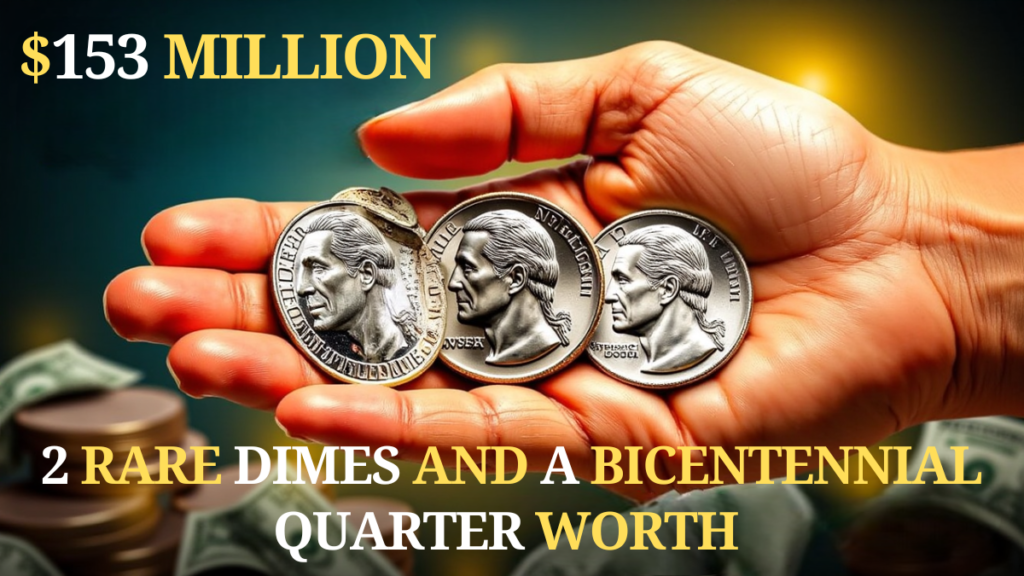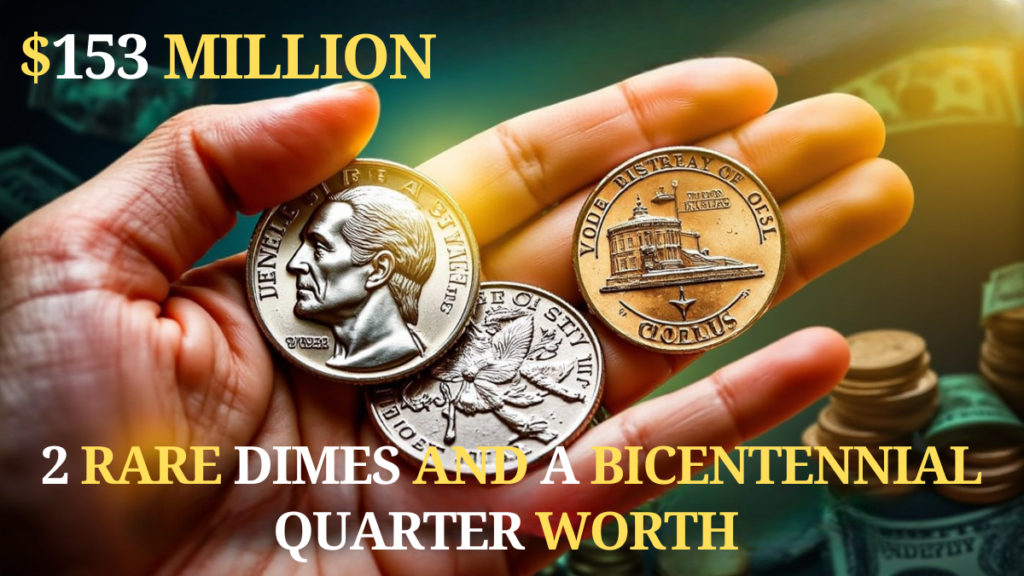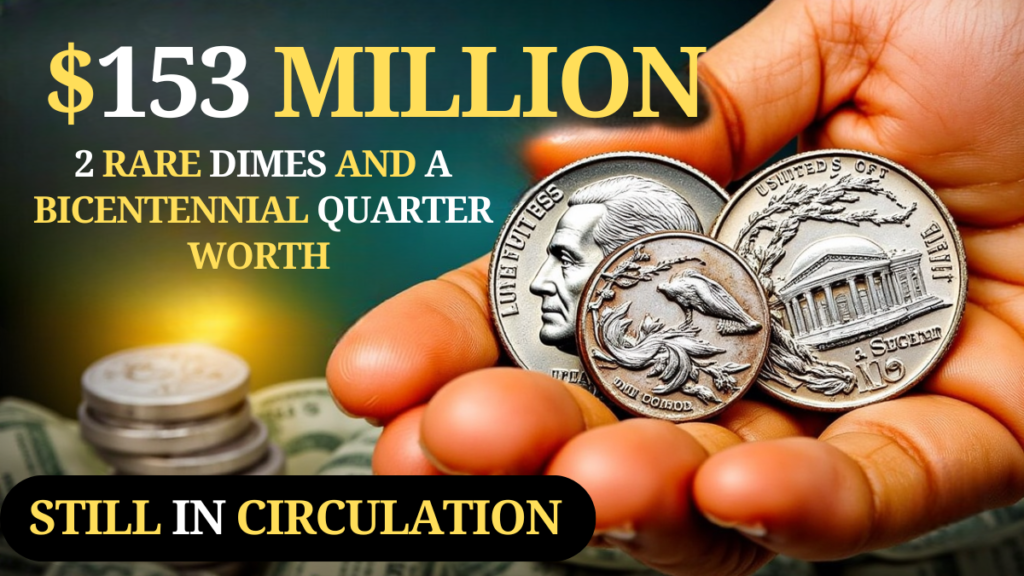2 Rare Dimes: Within the vast expanse of numismatics, few tales entice the imagination quite like the prospect of finding million-dollar coins hiding in ordinary pocket change. The notion that commonplace coins might actually be worth astronomical amounts is a hopeful fantasy for collectors and onlookers both.
Rare coin specialists estimate that millions of dollars’ worth of precious coins are still out in circulation, being carelessly handled by unsuspecting people as part of everyday transactions.
These numismatic gems are worth more than just dollars and cents to collectors these are history books in the making that narrate intricate tales of American minting history, which capture the progression of our country’s currency and the sophisticated artwork of coinage throughout the decades.
2 Rare Dimes The Mythical $153 Million Coins: Separating Fact from Fiction
Although the allegation of certain dimes and a Bicentennial Quarter being worth $153 million apiece must be considered with high degrees of skepticism, the rare coin collecting business is replete with incredible valuations that continue to impress both amateur collectors and veteran numismatists alike.
Coin collectors realize that some rare specimens can fetch prices far beyond their face value and that some coins sell for millions of dollars at name auctions.
The likelihood of finding such treasures provides a continual thrill and sense of possibility within the numismatic community, compelling hobbyists to carefully sift through their change and generating interest in coin collecting among succeeding generations of collectors.
These incredible valuations usually result from a perfect storm of historical importance, scarcity, and superior preservation.
2 Rare Dimes Understanding Coin Rarity and Value

Factors Determining Coin Value
There are a number of key factors that determine the potential astronomical value of a coin:
- Mint Condition: Preservation is key, with coins in mint, uncirculated condition receiving the highest premiums. Even slight wear or handling marks can have a big effect on value.
- Rarity of Mintage: How many coins in a particular run of mintage influence their limited availability and relative worth. Coins from more limited productions, or those done at smaller mints, have higher premiums.
- Historic Significance: Coins minted at times and events of ultimate importance in America, or with strong stories on why they had to be created, tend to command more fascination and worth.
- Unique Minting Errors: Mistakes during the minting process can create rare variations that collectors eagerly seek, sometimes resulting in extraordinary valuations for these numismatic anomalies.
- Preservation Quality: The methods used to store and protect coins over decades or centuries can dramatically influence their current condition and value.
Experts emphasize that not all old coins are valuable, and age alone doesn’t guarantee worth.
The most prized specimens typically result from unique minting circumstances, production errors, or extremely limited mintage runs that created scarce varieties.
The difference between an ordinary coin and a multi-million-dollar treasure can be as subtle as a minor minting mark or an almost imperceptible variation in design, requiring careful examination and expertise to identify.
The Bicentennial Quarter: A Potential Hidden Treasure
The Bicentennial Quarter, struck in 1975 and 1976 to celebrate 200 years of American independence, is a unique entry in numismatic history. Most Bicentennial Quarters are worth their face value, but some rare examples can command as much as $19,200, especially those in mint, uncirculated condition.
These special quarters are an interesting chapter in American coinage, with distinctive designs that broke from standard quarter imagery. Collectors should seek out certain characteristics:
- Distinct minting flaws that were encountered on the one-time production runs
- Flawless preservation with no evidence of handling or circulation
- Particular mint marks that are used to signal rarer manufacturing plants
- Strange strike traits that could point towards valuable variants
2 Rare Dimes Identifying Potentially Valuable Dimes
Key Characteristics of Rare Dimes
Dime collectors need to take special note of:
- Dimes with production mint flaws that have resulted in double strikes or off-center strikes
- Uncommon mint marks that could suggest short runs of production
- Low mintage dates when fewer coins were made
- Certain production variations that may suggest unusual die pairings or test strikes
These features can turn a common dime into a valuable collector’s piece, although such discoveries need to be thoroughly authenticated and appraised by experienced numismatic professionals.
The most highly prized dimes tend to surface in the most unlikely locations, with some of the rarest and most highly prized examples turning up in regular pocket change and general circulation.
Trained numismatists always stress the need for careful inspection of coins, noticing subtle variations, minute details, and unique traits that might hold the key to exceptional value.
These facts could consist of individual mint marks, subtle differences between design features, or even appearing minor flaws, which can actually indicate worthwhile mint errors.
2 Rare Dimes The Importance of Professional Authentication
Although finding a coin to be worth a million is unmistakably thrilling and riveting, professional authentication cannot be overestimated in the arena of numismatics.

Professional and reputable coin grading services deliver thorough, definitive opinions on the authenticity, state of a coin, and actual market value. These professional assessments incorporate advanced analysis methods, specialized equipment, and decades of specialized experience.
Serious collectors and hobbyists are strongly encouraged to have their coins professionally evaluated and certified before they make any major claims about a coin’s value or try to sell potentially valuable specimens. This prevents disappointment and ensures precise valuation of any significant finds.
2 Rare Dimes Preservation and Handling
For those who suspect that they may have found a valuable or rare coin, the right handling and conservation methods are absolutely essential to protecting its worth:
- Avoid cleaning or handling the surface of the coin, as even light cleaning can ruin the original patina forever.
- Store coins in a regulated setting where there is stability of temperature and humidity.
- Utilize only professional-grade, archive-quality protection holders specifically engineered for numismatic preservation.
- Keep exposure to environmental pollutants, such as air pollutants, humidity, and toxic chemicals, to a minimum.
2 Rare Dimes The Psychology of Coin Collecting
Aside from the strictly financial considerations, coin collecting is a captivating and multilayered convergence of historical value, artistic appreciation, and investment potential. Every rare coin is a singular historical artifact, successfully capturing and holding a moment in time while protecting an integral part of our collective cultural heritage.
The constant potential for finding a secret numismatic treasure turns the mundane process of looking at plain change into a thrilling adventure of anticipation and potential. This psychological element of coin collecting produces a strong attraction that keeps drawing new collectors to the hobby.
2 Rare Dimes Conclusion: A World of Possibility
Although assertions of individual coins being worth staggering amounts such as $153 million are subject to extensive documentation and verification, the intriguing realm of rare coin collecting still presents real opportunities for extraordinary finds.
Read More :- Rare Lincoln Wheat Penny Valued at $950K – Is It Still in Circulation?
Each handful of pocket change could possibly hold an untold tale in store for the discovering—it’s a reminder, always, that great value and historical interest may be hidden in the most mundane and least likely of sources.
The prospect of discovering such treasures lends an excitement to ordinary transactions and makes collectors keen in pursuit of worthy specimens. For serious collectors and ardent numismatists, the eternal search for coveted coins goes on with unrelenting passion.
Every coin is not only a possible monetary windfall but also a palpable link to our shared past—a physical bond to historical moments, artistic pursuits, and technological advancements that have formed our nation’s financial infrastructure.
This blend of historical value, aesthetic appeal, and possible worth guarantees that the study of numismatics will be a dynamic and interesting field in the future.
FAQs:-
What makes these dimes and quarter worth $153 million each?
These coins have rare minting errors, historical significance, and unique characteristics that make them highly valuable.
What is the best way to store valuable coins?
Store them in protective holders, coin albums, or safe deposit boxes to prevent damage and preserve their value.
Where can I get my coin authenticated?
You can get your coin authenticated by professional grading services like PCGS (Professional Coin Grading Service) or NGC (Numismatic Guaranty Corporation).

